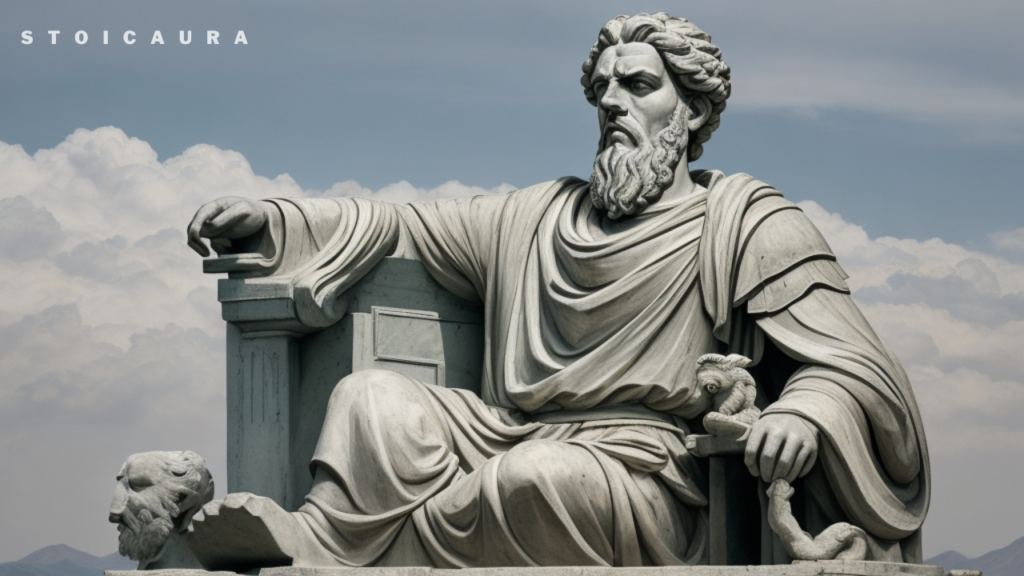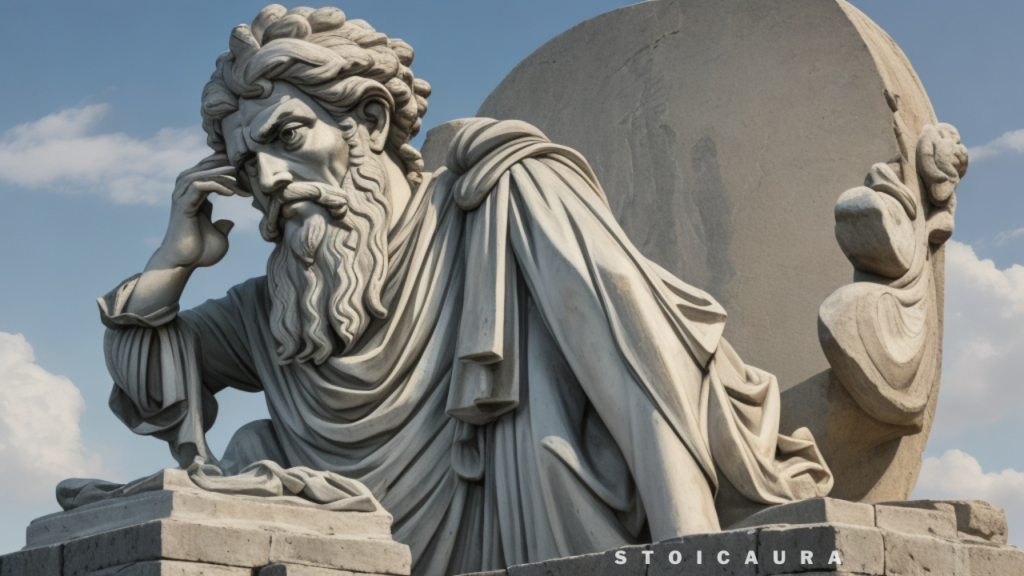
Introduction
Ever feel like you’re on an endless treadmill, chasing happiness but never quite catching it? What if the secret to eternal contentment isn’t about chasing anything at all but finding peace right where you are? Welcome to the world of Stoicism, an ancient philosophy that might just be your ticket to lasting joy. But what exactly is Stoicism, and how can its principles profoundly transform your approach to daily life and happiness? As we peel back the layers of this powerful philosophy, get ready to uncover the secrets to not just surviving the ups and downs of life, but thriving through them with unparalleled serenity.
Join us as we explore how adopting a Stoic mindset can lead to deep, enduring contentment and revolutionize your mindfulness and wellness practices. Let’s dive into the stoic secrets that have stood the test of time, helping countless individuals cultivate inner peace and resilience.
What is Stoicism? The Philosophical Roots of a Content Life
Curious about “What is Stoicism?” This ancient philosophy, born in the bustling heart of early 3rd century BC Greece, is more than just a set of ideas; it’s a practical guide to living a content life. Stoicism teaches that true happiness doesn’t depend on worldly goods or social status, but on our own internal virtues and our responses to external events. The Stoics, like the famously serene Marcus Aurelius or the steadfast Seneca, championed the pursuit of wisdom, courage, justice, and moderation. They believed that developing these virtues would lead to a life of peace and satisfaction, regardless of external circumstances.
So, how exactly can understanding “What is Stoicism?” impact your life today? Well, it offers a robust framework for dealing with life’s inevitable challenges. By embracing Stoic principles, you learn to detach from the chaos of uncontrollable events and focus instead on your ability to respond with composure. This mindset fosters resilience, allowing you to navigate both minor irritations and major crises with grace and equanimity.
Incorporating “What is Stoicism?” Integrating this into your daily life goes beyond simply reading ancient texts; it involves actively engaging in restraint, cultivating gratitude, and practicing thoughtful reflection. Whether it’s choosing not to lose your temper in traffic, or maintaining dignity under pressure, Stoicism equips you with tools to reduce stress and enhance joy. Embracing these principles can transform mundane moments into opportunities for growth, helping you build a deeply content and philosophically rich life.
The Stoic Formula for Happiness: Understanding Control and Acceptance
At the heart of “What is Stoicism?” lies a compelling formula for happiness: the art of control and acceptance. This Stoic philosophy suggests that true contentment is found not in reshaping the world to our desires, but in aligning our desires with the world as it is. Stoics divide life’s events into two categories: things we can control—like our actions and attitudes—and things we can’t control—such as other people’s actions and many external circumstances. This distinction is crucial because it empowers us to focus our energy on our own behaviors and responses, which are within our control, while accepting what lies beyond our reach.
Understanding “What is Stoicism?” involves recognizing that frustration and disappointment often stem from unrealistic expectations about what we can control. By recalibrating our expectations to focus on our own virtue and actions, we can dramatically reduce unnecessary stress and increase our overall happiness. For example, you can’t control the weather, but you can control your preparation for it; you can’t control someone else’s rudeness, but you can control your reaction to it.
This Stoic approach to life doesn’t mean being passive or indifferent, but rather actively engaging with the world in a way that emphasizes personal responsibility and inner strength. It’s about making peace with the unpredictable and focusing on self-improvement and resilience. So, when pondering “What is Stoicism?”. Consider it a roadmap for preserving your calm and dignity amid life’s inevitable turmoil, ultimately leading you towards a genuinely joyful existence.

When you’re hitting a rough patch, “What is Stoicism?” can provide some solid guidance on how to navigate daily challenges with a cool head and a steady heart. Stoicism, an ancient philosophy with modern-day relevance, teaches us to differentiate between what’s within our control and what’s beyond it. This simple yet profound understanding is the cornerstone of handling life’s ups and downs effectively. By focusing our efforts only on things we can influence—like our behavior, our responses, and our attitudes—we avoid wasting energy on the uncontrollable elements of life.
Stoicism isn’t about suppressing emotions; rather, it encourages a thoughtful awareness of them, guiding us to react not impulsively, but with reasoned responses. For instance, if traffic makes you late to a meeting, instead of fuming over the inevitable, a Stoic finds calm in accepting the situation and using the time to perhaps listen to a podcast or reflect. This shift in perspective doesn’t just reduce stress; it enriches your life with a deeper sense of purpose and peace.
So, “What is Stoicism?” It’s your go-to for learning not to sweat the small stuff—and even the big stuff. It arms you with strategies to remain tranquil in chaos and proactive in adversity. Every challenge becomes a chance to practice patience, fortitude, and resilience, making you not just a survivor of daily battles but a wise navigator through the storms of life. Dive into Stoicism, and watch your days transform from sequences of trials to opportunities for growth.
Achieving Peace of Mind: Stoic Practices for Modern Times
If you’re on a quest to achieve peace of mind, diving into “What is Stoicism?” could be your golden ticket. Stoicism, a philosophical gem from ancient Greece, is surprisingly fitting for the modern hustle. It teaches us to embrace life as it comes, focusing on our actions and reactions, which are the true markers of our control. In a world full of noise and chaos, adopting Stoic practices can lead to profound tranquility and resilience.
So, how exactly does Stoicism fit into contemporary life? It’s about simplicity and perspective—learning to separate trivial inconveniences from genuine problems and reacting to them accordingly. For instance, instead of spiraling into frustration over a cancelled flight, a Stoic approach would focus on enjoying some unexpected free time. Practicing mindfulness, another key Stoic practice, involves being fully present in the current moment, which can dramatically reduce anxiety about the past or future.
Moreover, Stoicism encourages reflection at the end of each day, a practice known as the philosophical diary. This isn’t about dwelling on what went wrong but rather considering what could be improved. This reflective practice helps to cultivate a mindset that is prepared and proactive rather than reactive.
Understanding “What is Stoicism?” gives you more than just historical knowledge; it equips you with practical tools to detach from external turmoil and foster an inner sanctuary of calm. So, next time you feel overwhelmed, remember that a Stoic finds serenity not by changing the world around them, but by refining their thoughts and reactions within it.
Real Stories of Contentment: How Stoicism Changes Lives
Ever wondered “What is Stoicism?” and how it could actually change a person’s life? This ancient philosophy isn’t just theoretical; it’s a powerful tool for real-life transformation. Across the globe, individuals credit Stoicism with helping them achieve deep contentment, regardless of external circumstances. Take, for example, Sarah, a busy executive who found herself overwhelmed by stress and anxiety. By applying Stoic principles, she learned to distinguish between what she could and couldn’t control, leading to significant improvements in her mental health and overall life satisfaction.
Another compelling story comes from Tom, a veteran who struggled with PTSD. He discovered that the Stoic practice of reflecting on his daily experiences helped him manage his emotional responses and foster a sense of peace. For Tom, understanding “What is Stoicism?” wasn’t just academic—it was a lifeline that brought him stability and joy in a world that once seemed chaotic.
These stories underscore a key facet of Stoicism: it teaches resilience and emotional fortitude, empowering individuals to lead happier, more balanced lives. By embracing Stoicism, people like Sarah and Tom find that they can face life’s challenges with a new level of calm and acceptance. This shift in mindset doesn’t erase difficulties, but it does change how they are experienced, making every challenge a bit more manageable and every joy a bit more profound. So, if you’re seeking a path to contentment, delve into Stoicism and see how it might reshape your perspective on life’s ups and downs.

Conclusion
In exploring the depths of “What is Stoicism?”, we’ve uncovered a treasure trove of wisdom that promises more than fleeting happiness—it offers a blueprint for eternal contentment. Stoicism teaches us the virtues of resilience, emotional control, and the clarity that comes from understanding what we can and cannot influence. It equips us to meet life’s chaos with grace and poise, transforming how we interpret and react to the world around us.
As we’ve seen, Stoicism isn’t just about enduring life’s storms; it’s about thriving within them. By adopting a Stoic mindset, you can experience a profound shift in your approach to daily challenges, leading to a life marked by deeper satisfaction and enduring peace.
If you’re intrigued by the potential of Stoicism to enhance your life, why not take the next step? Begin by integrating Stoic practices into your daily routine—practice mindfulness, reflect on your experiences, and focus on what you can control. Explore more about this enriching philosophy through books, courses, or community discussions. Embrace the Stoic journey and join a centuries-old community of thinkers who have found true contentment not by seeking more, but by cherishing the simple, rational, and beautiful elements of life. Let Stoicism guide you to a life not just lived, but well-lived.







